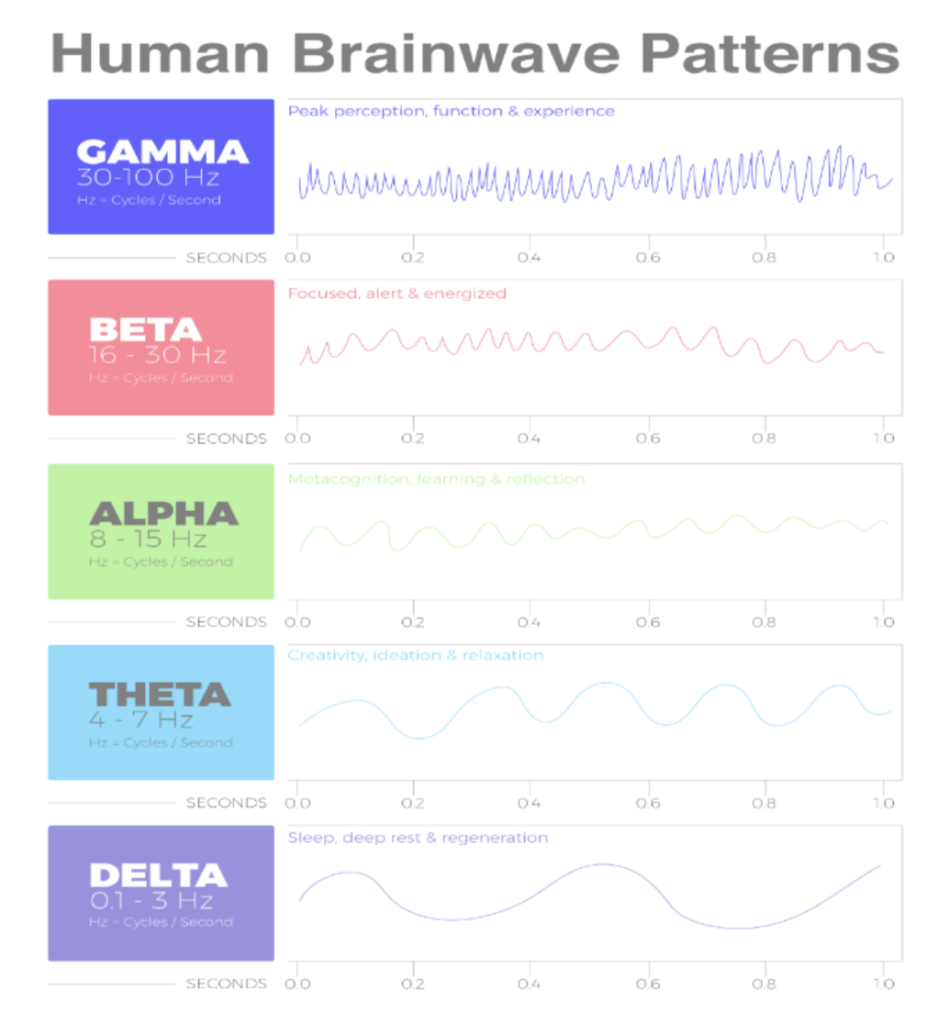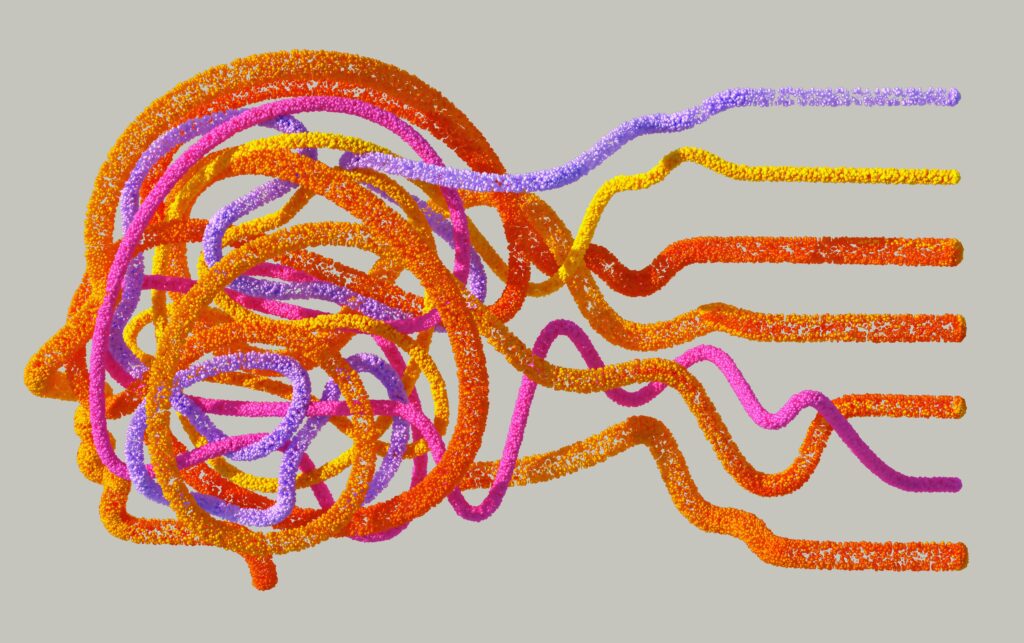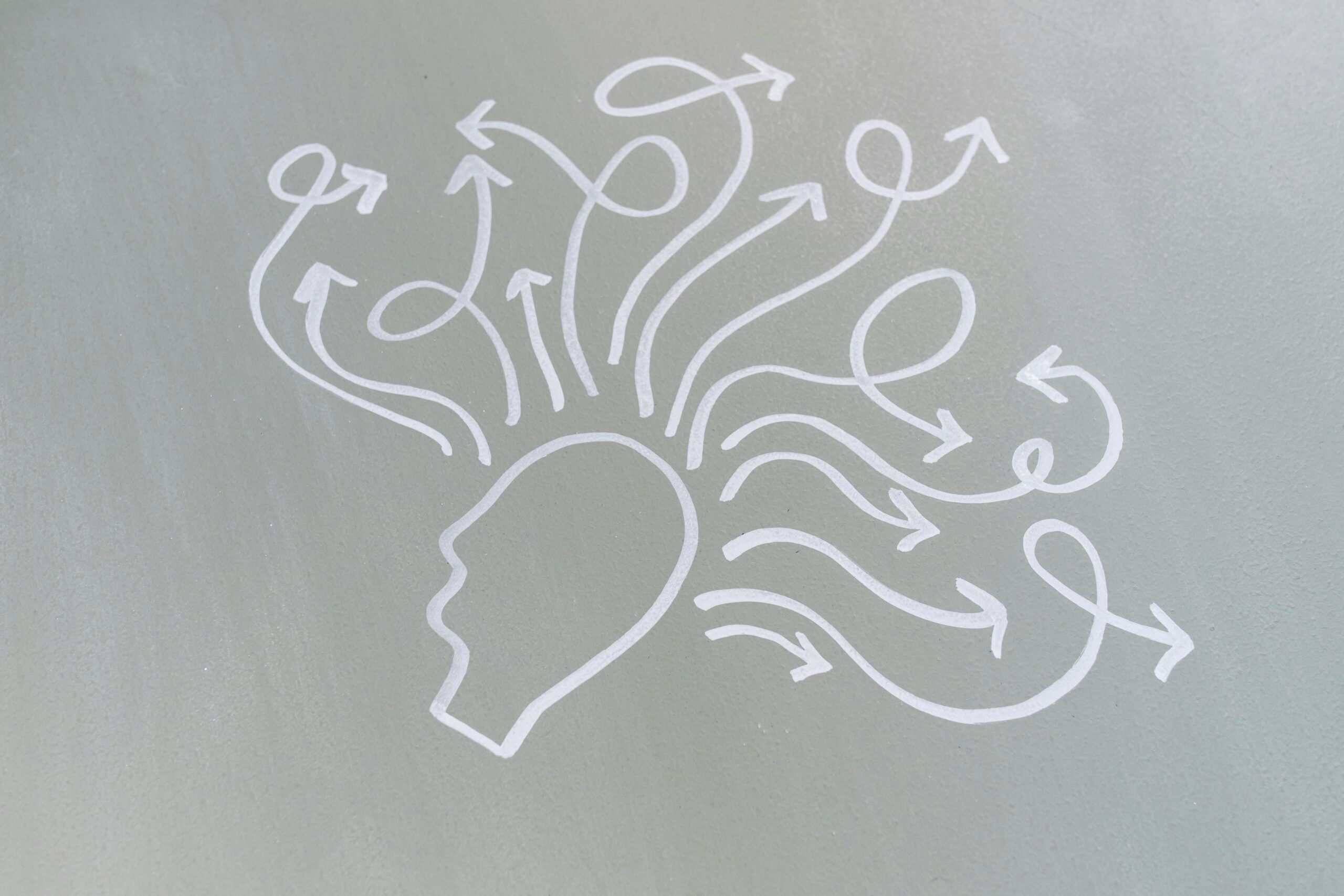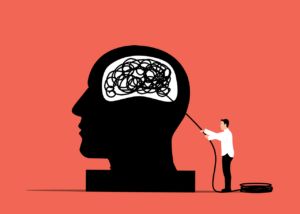“Brainwaves are the electrical activity of the brain, as measured by an electroencephalogram“ (EEG). – DR GREG WELLS
Have you noticed how your moods, thought patterns, energy levels, concentration etc are continually changing and wondered why?
Allow me to tell you – it’s because our Brainwaves are continually changing depending on what we’re experiencing and / or doing.
Let’s go into this in a bit more detail.
The brain typically cycles through different brainwave states as our level of consciousness changes. For example, during sleep, our brains move through different stages of brainwave activity, including Delta and Theta Waves, while during wakefulness, the brain primarily produces Beta and Gamma waves.
It is important to note however, that brainwave activity can be affected by various factors such as mental and physical state, medications and external stimuli.
Conventional wisdom has always said that achieving more means pushing harder. That’s not true. Our brains aren’t built to be in constant “go” mode. Of course, there are times when pushing ourselves to the limit is important. But those moments can’t happen without some R & R. So knowing how and when to step back enables us to achieve peak performance when a big moment comes along.
We need to be intentional about giving our brain what it needs for not only focused execution, but also for strategic thinking, creativity, recover and ultimately peak performance. By manipulating our body, mind and environment, we can learn how to enter into our desired performance state when needed.
There 5 different brainwave states. These are – Beta, Alpha, Theta Waves, Delta & Gamma.
Each one is linked to a particular performance state that, when engaged, brings us specific benefits that ultimately leads to our optimal performance.
Below is an overview of the different human brainwaves. Each type of brainwave is critical for optimal brain function. By intentionally triggering these brain states, we can achieve our potential – I’ll go into each of these states later on.

Gamma – Flow and Peak Experience
Gamma Brainwaves are the fastest type of Brainwave and oscillate at a frequency of between 25 and 100 Hz. They are associated with higher cognitive processes such as perception, problem solving and memory. Gamma Brainwaves are also thought to be involved in consciousness and the integration of information from different parts of the brain. They have been observed in the brain during tasks that require attention and focus, as well as during meditation and other spiritual practices. Some research has suggested that individuals with higher levels of Gamma Brainwaves may have better cognitive function and may be more resistant to age-related cognitive decline. However, more research is needed to fully understand the role of Gamma Brainwaves in the brain and their potential therapeutic uses.
Gamma waves are associated with being in a peak mental state and when we feel we are on top of the world feeling like we can get anything done. Our entire brain works together, our body is in the zone and our mind is at peak performance — we are in a state of flow. While this peak performance is desirable, it’s unreachable if we cannot allow our brain time to refocus, reflect, relax and recover as well.
Beta – Focused Execution
Beta Brainwaves are a type of Brainwave that occur in the frequency range of 13-30 Hz. They are associated with the normal waking state of the brain and are most prevalent when an individual is alert, focused and engaged in cognitive tasks or problem-solving. During Beta Brainwaves, the brain is processing a significant amount of information and is actively engaged in decision making, planning and other higher cognitive functions. They are associated with the activity in the neocortex, the outermost layer of the brain which is responsible for conscious thought, perception and voluntary movement. Neocortex is a Latin for “new rind” or “new bark”. It is a complex structure – dozens of cells, intricate connectivity patterns, and multiple layers and is a part of the cerebral cortex and a cortical part of the limbic system. It consists of grey matter that surrounds the deeper white matter of the cerebrum which is the anterior and largest part of the brain. It consists of 2 halves or hemispheres and controls voluntary movements and coordinates mental actions. The Neocortex accounts for about 76% of the total brain volume and is the largest and (evolutionarily) most recent portion of the cerebral cortex which is a complex layered tissue. It’s the site of most of the higher brain functions
Beta Brainwaves are also associated with stress and anxiety. High levels of Beta activity can lead to feelings of agitation, restlessness and difficulty relaxing. In contrast, lower levels of Beta activity can lead to feelings of calm and relaxation.
Research has found that certain types of therapy, such as, Hypnotherapy and Mindfulness can help to reduce Beta Brainwave activity and increase levels of relaxation and calm.
Overall, Beta Brainwaves play an important role in our cognitive function, attention, focus and emotional regulation. They are associated with the normal waking state of the brain, but when excessive can lead to feelings of stress and anxiety. These waves are linked to mental activities such as problem-solving, decision-making and critical thinking.
When we are in a state of deep focus and directed attention, the electricity passing between neurons in our brain happens at a rate of 16 to 30 cycles per second (Hz) , and in this state, we have the ability to stay deeply focused with sustained concentration – an important tool to manage stress and perform at a higher level. We need to be aware, however, that when we are in deep-focus (Beta Brainwave) mode, we are burning huge amounts of mental and physical energy. The goal here is to train ourselves to control our attention and then recharge so we can continue to enter deep focus states. Alternating periods of intense focus with periods of rest will allow for the optimal balance necessary to perform at our best at work and in life.

Alpha – Reflect and Learn
Alpha Brainwaves are a type of neural oscillation that occurs in the brain in the frequency range of 8-13 Hz. They are typically associated with a relaxed and alert state of mind, such as when we are in a meditative or daydreaming state.
Alpha Brainwaves are generated in the thalamus and are present during wakeful relaxation with closed eyes.
Our thalamus is our body’s information relay station. All information from our body’s senses (except smell) must be processed through our thalamus before being sent to our brain’s cerebral cortex for interpretation. Our thalamus also plays a role in sleep, wakefulness, consciousness, learning and memory.
These waves are also present in light sleep and during periods of decreased attention to the external environment. They are often considered to be a bridge between the waking and sleeping states.
Research has shown that increasing Alpha Brainwave activity may lead to improved mood, decreased anxiety and increased feelings of calm and relaxation. This is why techniques such as Hypnotherapy, Meditation and Mindfulness have been found to increase Alpha Brainwave activity.
It is also found that Alpha Brainwaves are related to improved memory and learning, as well as enhanced creativity and problem-solving abilities. This is because Alpha Brainwaves are associated with a state of mind in which the brain is open to new ideas and possibilities and the individual is better able to process and integrate information.
Overall, Alpha Brainwaves play a vital role in maintaining a balance between a relaxed and alert state of mind and have been found to be beneficial for both physical and mental well-being.
Alpha brainwaves tend to come to the fore during acts of reflection and metacognition ( higher-order thinking that enables understanding, analysis and control of the cognitive processes, especially when learning), which is when we are aware of our own thoughts. When we are laser-focused on something, we tend to miss the bigger picture. The Alpha brain state allows us to take in the full picture, deconstruct it and engage in strategic thinking so that we can properly learn and gauge a situation. In this state, our body is calm. These are the moments when we’re in a brainstorming session and we lean back, body relaxed and take a moment to think. Learning to be reflective is an essential skill if we want to contemplate, gain insights, learn and gain perspective on our life.
Theta Waves – Relax and Create
Theta Brainwaves are associated with certain states of consciousness, including deep relaxation and meditation. They have a frequency range of 4-7 Hz and are considered the “bridge” between Alpha and Delta Brainwaves.
Theta Waves are associated with the following:
Deep relaxation: Theta Waves are most prominent during states of deep relaxation and meditation and are thought to play a role in calming the mind and reducing stress.
Creativity: Theta Waves are also associated with creative thinking and problem-solving and may be involved in the generation of ideas and the retrieval of memories.
Sleep: Theta waves are present during light stages of sleep, such as stage 1 and stage 2 non-REM sleep and are thought to play a role in the transition between wakefulness and sleep.
Learning and Memory: Theta waves are associated with learning and memory and may be involved in the process of consolidating new information into long-term memory.
Hypnosis: Theta Brainwaves are also linked with hypnosis and self-hypnosis and are thought to be involved in the induction of hypnotic trance and the suggestion of hypnotic comm ands.
Overall, Theta Brainwaves play an important role in regulating various cognitive and emotional processes and are closely associated with states of deep relaxation, creativity and sleep.
Theta Brainwaves are relatively slow and are associated with drowsiness, light sleep and dreamy states. States where the brain exhibits Theta Brainwaves allow us to unleash our creativity. To get into this state, our body is often in a rhythmic movement, like walking, biking, or running. This puts our mind into a meditative state. We can also use mindfulness practices to enter this state and keep us in the present moment. By relaxing our bodies, we can enter this state – a state where we can come up with new solutions to old problems.
Delta – Rest and Regenerate
Delta Brainwaves are the slowest type of Brainwave, with a frequency range of 0.5 to 4 Hz. And are associated with deep sleep. They are most commonly associated with deep, dreamless sleep. They are also present during periods of deep meditation and some forms of hypnosis. The purpose of Delta Brainwaves is to help the body and mind enter a state of deep rest and repair. During periods of Delta wave activity, the body’s healing and regenerative processes are enhanced and the immune system is strengthened. Additionally, Delta Brainwaves are thought to be involved in the regulation of the sleep-wake cycle and the process of dreaming. They are also believed to play a role in the regulation of the endocrine system and the release of certain hormones. Overall, Delta Brainwaves are an essential part of a healthy sleep-wake cycle and are important for overall physical and mental well-being.
It’s the most important time for our brain to rest, recover and re-energize. Sleep is when we recoup our energy levels and when our nervous system recovers and regenerates. Sleep is when anabolic hormones that repair tissues and stabilise our energy levels are released. Sleep is also when we grow new neurons and establish new connections in the brain, which is one of the ways that we learn and create memories. When we take the time to recover and regenerate properly, we are able to perform better and achieve more, even if it feels like it’s taking up our time. Our body and mind will thank you later!
All of these brain states feed into each other to give us this moment of peak performance.
By leveraging the science of brainwave states, we can learn to increase focus, boost learning and creativity, maximize recovery and perform at the highest level.
If you’d like to know more about this fascinating topic and delve into the science of brainwave states, I’d recommend Rest Refocus Recharge: A Guide for Optimizing our Life. By Dr. Greg Wells





